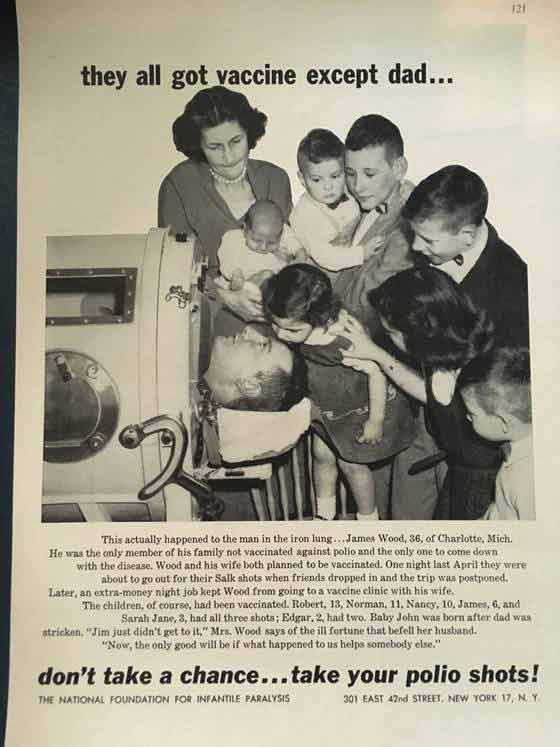
This story is about polio, pesticide poisoning as a possible cause of it, and the meaning of science. We are taught that the science on polio has been settled — but is it so? And what if the world is far more complex than we think, and “the science” is not settled at all?

How Do We Know That Something Is Really True?
Being human comes with interesting epistemological challenges, especially at a time like today. We believe that we have a grip on reality — but our history is usually written by the winners — and the winners have a tendency to create their own reality that serves their own interests and convictions — and to propagate that reality with vengeance, insisting that it’s “the truth.”
We are born into a world where our parents and teachers often live off assumptions that are not necessarily true. Naturally, we inherit many of their assumptions — and then end up either carrying the torch and internalizing the manufactured reality — or waking up one day, realizing that we’ve been lied to, and shaking our heads in disbelief as we try to figure out if any of what of we’ve been taught was true. Many of us can relate to that liberating and interesting experience of awakening!
Sometimes, the answers are readily available once we look — and sometimes, we learn that even the breadcrumbs leading to the truth have been carefully swept away over decades or centuries — and so we have to just be humble and patient, use our instincts, our heads and our hearts, do our best, and pray that one day, we may know the truth.
Being human is an exercise in patience and humility, that’s for sure! With that in mind, let’s look at the curious case of polio, DDT and other pesticides, and vaccines.
The Official Story of Polio
We all know the official story of polio: In the early 20th century, a polio epidemic showed up in the affluent West, and it was bad.
Then in 1954, the Salk Institute came up with a great polio vaccine — and hooray! The epidemic was stopped, and the people were no longer getting polio. Problem solved! Vaccines save lives! (Therefore, it is immoral, unthinkable and despicable to ever doubt any vaccines. Any questions? Hope not. Case closed.) But is it really closed, or is there room for debate?
First, let’s examine the official theory about the onset of the polio epidemic that accidentally reveals a “bug” in modern science where the scientists go after fixing one thing — assuming they know better than nature — and then break something else that they have not quite thought through. And so then they “patch” it, and break something else, and so on.
And at each turn, there is usually someone promoting each patch as the greatest thing in the world — while insisting that only a fool would consider unwrapping this “cabbage” of fixes and asking the village yokel question: “Is it possible that we haven’t quite thought things through at the very first turn, and should we maybe finally think it through at long last, and change our approach accordingly?”
So here is the official theory of why polio outbreaks started happening, as told on HistoryOfVaccines.org:
“Polio reached epidemic proportions in the early 1900s in countries with relatively high standards of living, at a time when other diseases such as diphtheria, typhoid, and tuberculosis were declining. Indeed, many scientists think that advances in hygiene paradoxically led to an increased incidence of polio.
The theory is that in the past, infants were exposed to polio, mainly through contaminated water supplies, at a very young age. Infants’ immune systems, aided by maternal antibodies still circulating in their blood, could quickly defeat poliovirus and then develop lasting immunity to it.
However, better sanitary conditions meant that exposure to polio was delayed until later in life, on average, when a child had lost maternal protection and was also more vulnerable to the most severe form of the disease.”
“Move Fast and Break Things”?
While this is only a theory, albeit an official one — and there are other theories we are about to explore — let me dare ask a village yokel question and just leave it out there: Is it possible that nature has things put together pretty well — and that “moving fast and breaking things” is a strategy that tends to backfire?
And while technology can be wonderful when used in balance, is it possible that it’s due to the destruction and poisoning of our environment — and our bodies, and our spiritual foundations, and our nurturing relationships — that we’ve become intoxicated, stressed out, prone to diseases, and dependent on industrial-strength “boosters” to stay in one piece?
Is it possible that if we got to the root of it and stopped poisoning our environment with such fervor, we’d be much healthier? Is it possible, at least as a thought experiment?
Poliomyelitis-like Symptoms Caused by Poisoning
In 1951, Dr. Ralph R. Scobey published an article in Archives of Pediatrics, titled “Is the public health law responsible for the poliomyelitis mystery?” (NIH link).
In the article, Dr. Scobey investigated the evidence showing the contagiousness (or not) of poliomyelitis — and talked about how the research into complex causes of the disease had been decapitated once the “official” opinion was declared. Among other things, he stated the following:
“Unlimited poliomyelitis research ceased abruptly when this disease was legally made a communicable disease. However, definite progress toward a solution to the problem was being made before the public health law made poliomyelitis a germ or virus disease. For example, it was reported by toxicologists and bacteriologists that poliomyelitis could be produced both by organic and inorganic poisons as well as by bacterial toxins.
The relationship of this disease to beriberi was also being given consideration. However, these investigations lost support when a germ or virus came to be considered by some to be the full and final answer to the problem. Funds for poliomyelitis research were from then on designated for the investigation of the infectious theory only.
There are today many investigators who have strong evidence contradicting the infectious theory. Vitamin and mineral deficiency, poison, allergy and other theories are being presented to explain the mystery, but these men, because of the public health law and the limited ability to obtain funds or cooperation from any source cannot work freely on the problem of cause of poliomyelitis.
At one time or another the classical dietary deficiency diseases, beriberi and pellagra, and even sunstroke, have been considered to be communicable infectious diseases. If by law any one, or all of these diseases, had been made a reportable communicable disease, it is obvious that today it would legally be a germ disease and a search for the causative germ might still be in progress.
If beriberi and pellagra had been made reportable communicable diseases, it is conceivable that the epochal studies on vitamins by Funk and subsequent workers could have been ignored in the search for the infectious agent as the etiological factor in these diseases. The progress of medicine would have been seriously retarded.
The time is long past due for careful reappraisal of the poliomyelitis problem and for many capable workers with various opinions regarding the cause of the disease to be given the opportunity to work and the funds with which to work. The implications of the public health law that poliomyelitis is an infectious communicable disease must be reconsidered if progress is to be made.”
The Rockefeller Brand
In his article, Dr. Scobey also mentioned that in 1911, Sachs [Sachs, B.: Am. J. Obst. & Gynec., 63: 703-710, April 1911] indicated that “Our present knowledge of the possible methods of contagion is based almost entirely upon the work done in this city at the Rockefeller Institute” and that children afflicted with the disease were kept in general hospital wards and that not a single one of the other inmates of the wards of the hospital was affected with the disease — which of course contradicted the “viral” theory of polio.
I would also like to point out the fact that the Rockefeller family, in general, has in many ways set the foundations of modern medicine as we know it — by funding specifically the research that they favored, medical school curricula that helped them shape the medical thinking in a way that would help them make the most money, and so on. There is a reason why today’s petrochemicals-based medicine has earned the nickname of “Rockefeller medicine“!
A Disclaimer
To me, the conversation about causes of polio is not about the hardcore debate about the germ theory vs. the terrain theory, it’s about truth in all its complexity. As a human being, I am at peace knowing that I don’t know the “final answer” to that important question. I think that “instant gratification” is not very helpful in science!
Thus, on my end, I am willing to listen to all sides — and keep listening, making my working theories, and changing my mind as many times as I want if good evidence presents itself. I suspect that both theories may explain a part of reality, and that with some wisdom, we can eventually figure out the balance. But in order to figure it out at any point, we need to be talking honestly and openly — and that’s exactly what’s not happening in today’s official scientific discourse!
More on Polio and Poisoning
In 1952, Dr. Scobey published a detailed “meta-analysis” titled, “The Poison Cause of Poliomyelitis And Obstructions To Its Investigation.” (NIH link), in which he looked at a broad range of studies and analyses that existed on the topic of polio — and he concluded that there seemed to be a causal relationship between polio outbreaks and consumptions of certain agricultural products, potentially linking polio to pesticide poisoning (for example, lead and arsenic compounds during this pre-DDT period.). Among other things, he noted:
“Paralysis, resulting from poisoning, has probably been known since the time of Hippocrates (460-437 B.C.), Boerhaave, Germany, (1765) stated: “We frequently find persons rendered paralytic by exposing themselves imprudently to quicksilver, dispersed into vapors by the fire, as gilders, chemists, miners, etc., and perhaps there are other poisons, which may produce the same disease, even externally applied.”
In 1824, Cooke, England, stated: “Among the exciting causes of the partial palsies we may reckon the poison of certain mineral substances, particularly of quick silver, arsenic, and lead. The fumes of these metals or the receptance of them in solution into the stomach, have often causes paralysis.””
“DDT Is Good For Me-e-e”
There was a time when DDT was advertised as “safe and effective.” It was supposed to be an extremely effective pesticide, and “the experts” recommended that DDT should be spayed everywhere. One of the “benefits” was preventing polio!
Parents sent their children to run after the trucks spraying DDT and also sprayed DDT everywhere in the house — clearly with the best of intentions, for the health of their kids and the household. Reminds you of anything? Take a look at the Time Magazine issue from June 30, 1947, that ran the following ad:

To my senses, these DDT advertisements were so incredibly hypnotizing because they were selling a fantasy: getting something for nothing. And they were making it sounds “scientific” and “respectable!” Here is this thing, they said, that kills pests like a murderer — but is entirely healthy for humans! Here’s your convenience! Here is your victory march over nature!
And this commercial below called DDT a “threat to insect’s life, liberty and pursuit of happiness” and “a handful of concentrated death”:
And here is a famous commercial that featured a civilized entomologist “selling” African tribesmen on the greatness of DDT. The skeptical tribesmen were depicted as your familiar village yokels, and one of their ridiculous, unscientific fears described in the video was that DDT could be poisonous.
DDT as a Possible Cause of Polio
There is a theory that DDT poisoning was a major contributor to paralysis diagnosed as polio. The timeline supports it, and it is one of those cases where I have to humbly accept not knowing the definitive answer at this very second.
The Salk vaccine was introduced in 1954. DDT was banned in the U.S. in 1972. Polio was officially eradicated in the U.S. in 1979. (The vaccine-derived version of polio (!) is reported to be spreading now in developing countries, and, according to ABC News, “More polio cases now caused by vaccine than by wild virus.“)
In 2021, Ryan Matters published an excellent, in-depth article called, “mRNA ‘Vaccines,’ Eugenics, and Push for Transhumanism,” in which he looked at the link between polio and DDT, among other things. (I very highly recommend reading his entire article.)
“One crop pesticide in widespread use at the time was DDT, a highly toxic organochlorine that was widely publicized as being “good for you”, but eventually banned in 1972. In 1953, Dr Morton Biskind published a paper in the American Journal of Digestive Diseases pointing out that:
‘McCormick (78), Scobey (100-101), and Goddard (57), in detailed studies, have all pointed out that factors other than infective agents are certainly involved in the etiology of polio, varying from nutritional defects to a variety of poisons which affect the nervous system.’
The danger of toxic pesticides, including DDT, and their disastrous effects on the environment were illustrated by Rachel Carson in her 1962 book, Silent Spring.
In more recent times, researchers, Dan Olmstead, co-founder of the Age of Autism, and Mark Blaxil conducted two brilliant investigations into the polio epidemics of the 20th century, reaching a similar conclusion to Scobey and Biskind, namely that the disease was caused by the widespread use of neurotoxic pesticides such as arsenite of soda and DDT.
Although Salk’s vaccine was hailed as a success, the vaccine itself caused many cases of injury and paralysis. And though there does appear to be a convincing correlation between the timing of the vaccine and the reduction in polio cases, as all good scientists know, causation doesn’t equal correlation, especially considering the fact that DDT was phased out, at least in the US, over the same period.”
An Indirect (and Sometimes Direct) Connection to Eugenics
In his article, Ryan Matters also pointed out the fact that “Dr Salk’s polio research was funded by the mother of Cordelia Scaife May, an heiress to the Mellon family banking fortune who idealized Margaret Sanger and later joined the board of the International Planned Parenthood Foundation,” and who supported compulsory sterilization as a means to limit birth rates in developing countries.
Notably, May was also was on the board of the Population Council, an organization founded by John D. Rockefeller III focused on population reduction. The passion of the wealthiest families for population control (under their leadership) and eugenics is not a conspiracy theory. It’s been thoroughly documented even in the mainstream media.
As far as Margaret Sanger of Planned Parenthood, in her 1932 “Plan for Peace,” she advocated for “a stern and rigid policy of sterilization and segregation to that grade of population whose progeny is tainted, or whose inheritance is such that objectionable traits may be transmitted to offspring,” as well as for “giving certain dysgenic groups in our population their choice of segregation or sterilization.”
By the way, according to Matters, in 1995, the Population Council collaborated with the WHO on their fertility regulating vaccines.
Food for Thought?
So let me just say that as much as vaccines — like any other medicine — can be of great use when done well, with integrity, and without fanaticism — the general topic of vaccines is a little less rosy and a little more murky than any one of us would want to believe in an ideal world. It all depends on who runs and programs and how — and the instinctive, history-based apprehensions of the village yokels are not without cause!
In conclusion, I will say that having the same group of people who have historically been big fans of eugenics now run both the official transition to what they call “the Fourth Industrial Revolution” and the global “health response” doesn’t make me feel relaxed. It’s a little unlikely that they have since repented and are now trying to help us.
I mean, yeah, miracles happen — and I want to believe in the goodness of people — but they still seem to be saying that we’ll be eating cockroach meat for our own good, so I don’t know …
About the Author
To find more of Tessa Lena’s work, be sure to check out her bio, Tessa Fights Robots.